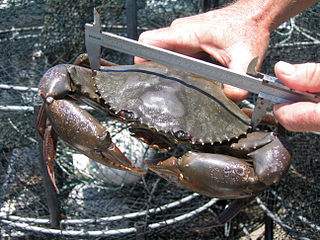
Streptomyces is the largest genus of Actinomycetota and the type genus of the family Streptomycetaceae. Over 500 species of Streptomyces bacteria have been described. As with the other Actinomycetota, streptomycetes are gram-positive, and have genomes with high GC content. Found predominantly in soil and decaying vegetation, most streptomycetes produce spores, and are noted for their distinct "earthy" odor that results from production of a volatile metabolite, geosmin.

Scylla serrata is an ecologically important species of crab found in the estuaries and mangroves of Africa, Australasia, and Asia. In their most common forms, their shell colours vary from a deep, mottled green to very dark brown.
Daeguia is a genus in the phylum Pseudomonadota (Bacteria).

Streptomyces hygroscopicus is a bacterial species in the genus Streptomyces. It was first described by Hans Laurits Jensen in 1931.
Streptomyces albogriseolus is a bacterium species from the genus of Streptomyces which has been isolated from soil. Streptomyces albogriseolus produces neomycin B and neomycin C.
Streptomyces avicenniae is a bacterium species from the genus of Streptomyces which has been isolated from the rhizosphere of the plant Avicennia marina in the Fujian Province in China.
Streptomyces coelicoflavus is a bacterium species from the genus of Streptomyces. Streptomyces coelicoflavus produces acarviosin-containing oligosaccharides.
Streptomyces mangrovi is a bacterium species from the genus of Streptomyces which has been isolated from mangrove soil from the Dongzhaigang National Nature Reserve from the Haikou City, in China.
Streptomyces pluripotens is a bacterium species from the genus of Streptomyces which has been isolated from mangrove soil from the Tanjung Lumpur river in Malaysia.
Streptomyces qinglanensis is a bacterium species from the genus of Streptomyces which has been isolated from mangrove soil from Wenchang in the Hainan in China.
Streptomyces sanyensis is a bacterium species from the genus of Streptomyces which has been isolated from mangrove soil in Sanya in Hainan in China. Streptomyces sanyensis produces indolocarbazoles.
Streptomyces shenzhenensis is a bacterium species from the genus of Streptomyces which has been isolated from mangrove soil in Shenzhen in China.
Streptomyces sundarbansensis is a bacterium species from the genus of Streptomyces which has been isolated from soil from a mangrove forest from the Lothian Island in India. Streptomyces sundarbansensis produces 2-allyloxyphenol.
Streptomyces xiamenensis is a bacterium species from the genus of Streptomyces which has been isolated from mangrove sediments in Xiamen in the Fujian Province in China. Streptomyces xiamenensis produces the antifibrotic drug xiamenmycin.
Streptomyces yanii is a bacterium species from the genus of Streptomyces which has been isolated from mud.
Tahibacter caeni is a Gram-negative, aerobic, non-spore-formin, rod-shaped and non-motile bacterium from the genus of Tahibacter which has been isolated from activated sludge from a wastewater treatment facility.
Streptomyces qinzhouensis is a bacterium species from the genus of Streptomyces which has been isolated from soil from the QinzhouBay in China.
Streptomyces monashensis is a bacterium species from the genus of Streptomyces which has been isolated from mangrove soil from Sarawak.
Flexivirga caeni is a Gram-positive, strictly aerobic, non-spore-forming and non-motile bacterium from the genus Flexivirga which has been isolated from activated sludge.
Alkalihalobacillus caeni is a Gram-variable, aerobic and motile bacterium from the genus of Alkalihalobacillus which has been isolated from sediments from the Bamen Bay mangrove forest in China.


